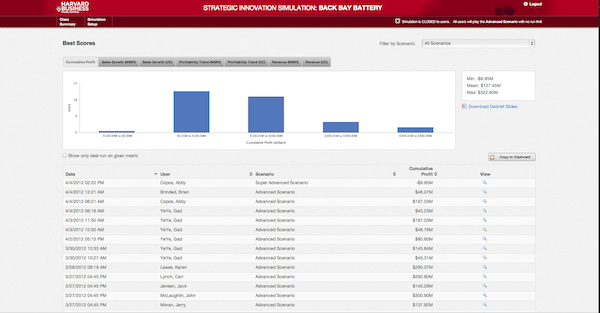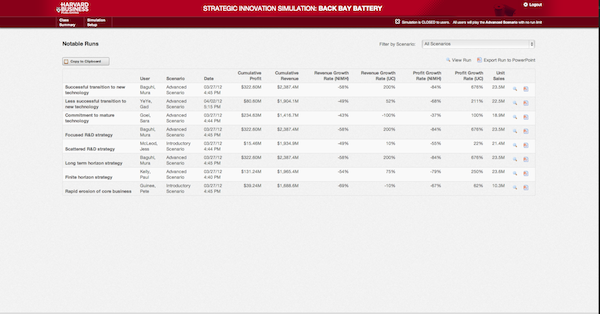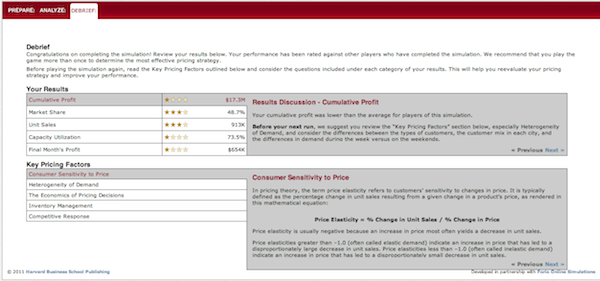Simulations vs. "the Sage on the Stage"
A recent article in Harvard Business Publishing’s newsletter explains how university faculty are using simulations in their classrooms.
Michael Roberto, a Professor at Bryant University and one of the faculty who developed the model behind the Everest Leadership and Teamwork Simulation, discusses why he uses simulations in his class:
“I believe strongly in active learning - where students don’t just sit passively listening to the ‘sage on stage’ but instead work on the problems and issues with their classmates. Simulations present one of the most dynamic forms of active learning. Students benefit because not only do they have to make a series of challenging decisions, but then they receive immediate feedback on those choices.”
As Professor Roberto explains, simulations give students the opportunity to concretely apply what they’ve learned in their classes. Simulations are typically used in the classroom for two purposes:
- Teach key concepts
- Evaluate student learning
Using Simulations to Teach Key Concepts
Traditionally, business school faculty have used case discussion, lectures, and reading material as the primary ways of presenting key concepts. Simulations offer the same opportunity to take an in depth look at selected business concepts, and also give students the chance to apply their learning in a simulated environment before testing their business acumen in the higher stakes environment of a corporate job or their own company.
Professor Willy Shih of Harvard Business School explains the use of simulations this way:
“While case method teaching is a wonderful way to examine theories or frameworks statically, simulations give students a temporal dimension, an opportunity to experience outcomes that change based on their inputs over time. Students get the tacit experience of making mistakes, learning from those mistakes, and then refining their decision making.”
Professor Shih helped develop the model behind the Strategic Innovation and Technology Simulation that Harvard Business School Publishing developed in partnership with Forio, based on The Innovator’s Dilemma by Clayton Christensen, in which students play the role of the CEO of Back Bay Battery, managing R&D investment tradeoffs between sustaining investment in their existing business versus investing in a new and potentially disruptive technology. If students spend too little, disruptive innovation becomes impossible; if they spend too much, they can be fired inside the game. Students have the opportunity to apply the principles they have learned in class as well as experiment with risk in a relatively consequence-free environment.
Because simulations allow the student to make many decisions over time and see the impact of each individual decision as well as the sum of all of their decisions, simulations are an excellent way of learning how actions exist within the context of a larger picture – so easy to miss in a higher pressure work environment when critical strategic decisions take place over a longer period of time. In a 90-minute simulation, it’s easier for students to connect day-to-day decisions to larger strategic objectives.
Simulations are a good way of helping students understand interrelated variables. In the Marketing: Managing Channels and Segments Simulation, students play the role of the CEO of Minnesota Micromotors. They are allocated a limited marketing budget that they must decide how to spend. With each decision the student makes about budget allocation, such as accommodating one segment’s desire for smaller motors and selling more motors to that segment, other areas are affected. Customers in a segment which prefers larger motors that do not overheat may be dissatisfied or drop Minnesota Micromotors as a supplier. If the marketing budget is not spent in a way that increases profit, it will eventually be cut, leaving the CEO with fewer options for spending and decreased potential for success.
Using Simulations to Evaluate Student Learning
Instead of exams or term papers, faculty sometimes use simulations to test what students have learned and their ability to apply that information.
Several features exist within Forio simulations to simplify grading. All Forio simulations include scoring options where professors can easily see in the format of a histogram how students’ scores compare to their classmates, making it easy for professors to grade on a curve. Faculty can also examine student performance according to more specific factors related to the learning objectives of the class.

In addition to providing easy options for student grading, simulations can offer the opportunity to evaluate student learning more comprehensively than test results. Professors often look at student performance within the simulation in an in-depth debrief. In a simulation debrief, professors will ask students to reflect on difficulties they encountered within the simulation and whether or not their strategy was effective. Students can compare and contrast their results with each other and reflect on what they might do differently if playing the simulation again. The debrief is one of the most valuable parts of any simulation, as it is the opportunity for students to synthesize what they have learned.
Recent features added to Forio simulations make the debrief and evaluation of student learning easier. Newer Forio simulations include the ability to export slides of student runs to PowerPoint for a simplified ability to go over simulation results in class. Professors can review “notable runs,” such as the best performing run in the class or examples of different strategic approaches. In the Innovation simulation, for example, professors can review student runs according to simulation approaches such as “Focused R&D Strategy,” and “Commitment to Mature Technology.”

Sometimes, simulations are used in adult learning or online educational environments where a professor does not lead a formal class debrief. For this reason, several simulations now include a “self-debrief” within the simulation where students can review their own performance.

